Integrated Investigations of Painting Materials in the Sasanian City of Ardaxšīr Khwarrah, near Firuzabad (Southern Iran)
Abstract
1. Introduction
2. Materials and Methods
2.1. Non-Invasive Investigations
2.1.1. Handheld USB Digital Microscope (DM)
2.1.2. Energy Dispersive X-ray Fluorescence (ED-XRF, µ-XRF)
2.2. Micro Invasive Investigations
2.2.1. Polarised Light Microscopy (PLM)
2.2.2. Scanning Electron Microscopy–Energy Dispersive X-ray Spectrometry (SEM/EDS)
2.2.3. Micro-Raman Spectroscopy (µ-Raman)
2.2.4. Fourier Transform Infrared Spectroscopy (micro-FTIR)
2.2.5. Gas Chromatography-Mass Spectrometry (GC-MS)
2.2.6. Pyrolisis-Gas Chromatography-Mass Spectrometry (Py-GC-MS)
2.3. Sampling
3. Results and Discussion
3.1. Wall Painting Finishing Plasters
3.2. Floor Finishing Plasters
3.3. The Palette
3.3.1. Yellow and White Pigments
3.3.2. Green Pigments
3.3.3. Red Pigments
3.3.4. Black Pigment
3.4. Analysis of the Organic Component
3.4.1. GC-MS Analysis
3.4.2. Py-GC-MS Analysis
4. State of Conservation
5. Conclusions
Supplementary Materials
Author Contributions
Funding
Data Availability Statement
Acknowledgments
Conflicts of Interest
References
- Ja’fari-Zand, A. The discovery of the funerary building with paintings in Shahr-e Gur (Ardaxšīr-Xwarrah) Firuzabad. In Firuzabad History and Culture; Karachi, R., Ed.; Institute for Humanities and Cultural Studies: Tehran, Iran, 2017; pp. 253–311. (In Persian) [Google Scholar]
- Bosworth, C.E. Ardašīr- Ḵorra. Iran. Antiq. 1986, II, 384–385. [Google Scholar]
- Bosworth, C.E. The Sasanids, the Byzantines, the Lakhmids, and Yemen (translated and annotated by C. E. Bosworth). In The History of al-Tabari (Ta’rikh al-Rusul wa’l-Mulnk); Ariomand, S.A., Ed.; State University of New York Press: Albany, NY, USA, 1999; Volume V. [Google Scholar]
- Stein, A. An Archaeological Tour in the Ancient Persis. Geogr. J. 1935, 86, 489–497. [Google Scholar] [CrossRef]
- Huff, D. Fīrūzābād. Iran. Antiq. 1999, IX, 633–636. [Google Scholar]
- Wiesehöfer, J. Das Frühe Persien. Geschichte Eines Antiken Weltreichs; Oscar Beck: München, Germany, 1999; Volume 94. [Google Scholar]
- Huff, D. Formation and Ideology of the Sasanian State in the Context of Archaeological Evidence. In The Sasanian Era. The Idea of Iran; Curtis, V.S., Stewart, S., Eds.; I. B. Tauris: London, UK, 2008; Volume III, pp. 31–59. [Google Scholar]
- Compareti, M. The State of Research on Sasanian Painting. e-Sasanika 2011, 13, 1–50. Available online: https://www.academia.edu/1809995/The_State_of_Research_on_Sasanian_Painting (accessed on 30 November 2023).
- Mousavi, A.; Daryaee, T. The Sasanian Empire: An Archaeological Survey, c. AD 220–640. In A Companion to the Archaeology of the Ancient Near East; Potts, D.T., Ed.; Blackwell Publishing: Oxford, UK, 2012; pp. 1076–1094. [Google Scholar]
- Callieri, P. Architecture et Représentations Dans l’Iran Sassanide (Studia Iranica. Cahiers, 50); Peeters: Louvain, Belgium, 2014. [Google Scholar]
- Huff, H. Das Plansystem von Ardašīr-xwarrah: Agrarkolonisatorisches Groβprojekt und gebautes Staatsmodell eines von Gott gegebenen Königtums. In Raumkonzeptionen in Antiken Religionen: Beiträge. Des Internationalen Symposiums in Göttingen, 28–29 Juni 2012; Phlippica, K.R., Ed.; Harrassowitz Pubblishing: Gottingen, Germany, 2014; pp. 153–210. [Google Scholar]
- Suren-Pahlav, S. Sasanian Art, the Main Source of Early Islamic Floor-Frescos. CAIS (The Circle of Ancient Iran Studies), 19 February 2006; School of Oriental and African Studies (SOAS): London, UK, 2006; Available online: https://www.cais-soas.com/News/2006/February2006/19-02.htm (accessed on 30 November 2023).
- Bartolucci, M. Il Complesso con Pitture al Centro della città di Shahr-e Gur (Firuzabad, Fars, Iran): Uno Studio Archeologico e Storico-Artistico. Ph.D. Thesis, Alma Mater Studiorum University of Bologna, Bologna, Italy, 2020. Available online: https://amsacta.unibo.it/id/eprint/7063/1/BartolucciMatteo2022_PittureShahr-eGur_ThTriennale2020_OAv3.pdf (accessed on 27 November 2023).
- De Waele, A. Sasanian Wall Paintings. Encyclopædia Iranica, 2009. Iranica Online. Available online: https://iranicaonline.org/articles/sasanian-wall-painting (accessed on 30 November 2023).
- Azarnoush, M. The Sasanian Manor House at Hājīābād, Iran; Le Lettere: Firenze, Italy, 1994. [Google Scholar]
- Matteo, C. Dinastie di Persia e Arte Figurativa: Bibliografia Ragionata per un Millennio e Mezzo di Iconografie Iraniche, Studia Persica, 2nd ed.; Paolo Emilio Persiani: Bologna, Italy, 2019. [Google Scholar]
- Loukonine, V.; Ivanov, A. L’Art Persan; Parkstone/Aurora: Bournemouth, UK, 1995. [Google Scholar]
- Kawami, T.S.; Becker, L.; Koestler, R. Kuh-e Khwaja, Iran, and Its Wall Paintings: The Records of Ernst Herzfeld. Metrop. Mus. J. 1987, 22, 13–52. [Google Scholar] [CrossRef][Green Version]
- Grenet, F. La peinture sassanide de Ghulbiyan (Afghanistan). Doss. D’archeologie 1999, 243, 66–67. [Google Scholar]
- Matteo, C. Iconographical notes on some recent studies on Sasanian religious art. Ann. Ca’ Foscari 2006, XLV, 163–200. [Google Scholar]
- Brend, B. Islamic Art; Harvard University Press: Cambridge, MA, USA, 1991. [Google Scholar]
- Holakooei, P.; Karimy, A.H.; Hassanpour, A.; Oudbashi, O. Micro-Raman spectroscopy in the identification of wulfenite and vanadinite in a Sasanian painted stucco fragment of the Ghaleh Guri in Ramavand, western Iran. Spectrochim. Acta A Mol. Biomol. Spectrosc. 2016, 169, 169–174. [Google Scholar] [CrossRef]
- Andreotti, A.; Bonaduce, I.; Colombini, M.P.; Gautier, G.; Modugno, F.; Ribechini, E. A combined GC-MS analytical procedure for the characterisation of drying oils, waxes, natural terpenoid resins, pitch, tars and proteinaceous materials in the same paint microsample. Anal. Chem. 2006, 78, 4490–4500. [Google Scholar] [CrossRef]
- Orsini, S.; Parlanti, F.; Bonaduce, I. Analytical pyrolysis of proteins in samples from artistic and archaeological objects. J. Anal. Appl. Pyrolysis 2017, 124, 643–657. [Google Scholar] [CrossRef]
- Krishnamurti, D. The Raman Spectrum of Calcite and its Interpretation. Proc. Indian Acad. Sci. 1957, 46, 183–202. [Google Scholar] [CrossRef]
- Berenblut, B.J.; Dawson, P.; Wilkinson, G.R. The Raman Spectrum of Gypsum. Spectrochim. Acta A Mol. Biomol. Spectrosc. 1971, 27, 1849–1863. [Google Scholar] [CrossRef]
- Huff, D. Qal’a-ye Dokhtar bei Firuzabad, Archäologische Mitteilungen aus Iran; Verlag: Berlin, Germany, 1971; Volume 4, pp. 173–175. [Google Scholar]
- Mousavi, A. Persia (Achaemenid to Sasanid Empires), c. 550 BCE–651 CE. In Sir Banister Fletcher’s Global History of Architecture; Fraser, M., Ed.; The Royal Institute of British Architects (RIBA) and the University of London: London, UK, 2019. [Google Scholar] [CrossRef]
- Hanesch, M. Raman spectroscopy of iron oxides and (oxy)hydroxides at low laser power and possible applications in environmental magnetic studies. Geophys. J. Int. 2009, 177, 941–948. [Google Scholar] [CrossRef]
- Frost, R.L. Raman microscopy of selected chromate minerals. J. Raman Spectrosc. 2004, 35, 153–158. [Google Scholar] [CrossRef]
- Gliozzo, E.; Ionescu, C. Pigments-Lead-based whites, reds, yellows and oranges and their alteration phases. Archaeol. Anthrop. Sci. 2022, 14, 17. [Google Scholar] [CrossRef]
- Stodulski, L.; Farrell, E.; Newman, R. Identification of Ancient Persian Pigments from Persepolis and Pasargadae. Stud. Conserv. 1984, 29, 143–154. [Google Scholar] [CrossRef]
- Holakooei, P.; de Lapérouse, J.-F.; Rugiadi, M.; Carò, F. Early Islamic pigments at Nishapur, north-eastern Iran: Studies on the painted fragments preserved at The Metropolitan Museum of Art. Archaeol. Anthropol. Sci. 2018, 10, 175–195. [Google Scholar] [CrossRef]
- Edwards, H.G.M.; Villar, S.E.J.; Eremin, K.A. Raman spectroscopic analysis of pigments from dynastic Egyptian funerary artefacts. J. Raman Spectrosc. 2004, 35, 786–795. [Google Scholar] [CrossRef]
- Liu, Z.; Xu, W.; Zhang, Y.; Wang, Y.; Li, J. Identification of the Pigments on the Mural Paintings from an Ancient Chinese Tomb of Tang Dynasty Using Micro-Raman and Scanning Electron Microscopy/Energy Dispersive X-ray Spectroscopy Analysis. Minerals 2023, 13, 1224. [Google Scholar] [CrossRef]
- Apopei, A.I.; Buzgar, N. The Raman study of amphiboles. Analele Stiintifice ale Universitatii “Al. I. Cuza’’ din Iasi Seria. Geologie 2010, 56, 57–83. [Google Scholar]
- Waeselmann, N.; Schlüter, J.; Malcherek, T.; Della Ventura, G.; Oberti, R.; Mihailova, B. Nondestructive determination of the amphibole crystal-chemical formulae by Raman spectroscopy: One step closer. J. Raman Spectrosc. 2020, 51, 1530–1548. [Google Scholar] [CrossRef]
- Rajabzadeh, M.A.; Rasti, S. Investigation on mineralogy, geochemistry and fluid inclusions of the Goushti hydrothermal magnetite deposit, Fars Province, SW Iran: A comparison with IOCGs. Ore Geol. Rev. 2017, 82, 93–107. [Google Scholar] [CrossRef]
- Amadori, M.L.; Vagnini, M.; Vivani, R.; Anselmi, C.; Askari Chaverdi, A.; Callieri, P.; Matin, E.; Mengacci, V. Advances in characterization of colourful residues unearthed in Persepolis West craft zone using microscopic and spectroscopic techniques. Microchem. J. 2021, 167, 106304. [Google Scholar] [CrossRef]
- Eastaugh, N.; Walsh, V.; Chaplin, T.; Siddall, R. The Pigment Compendium: A Dictionary of Historical Pigments, 1st ed.; Elsevier and Butterworth-Heinemann: Amsterdam, The Netherlands; Boston, MA, USA, 2004. [Google Scholar]
- Filippakis, S.E.; Perdikatsis, B.; Paradellis, T. An Analysis of Blue Pigments from the Greek Bronze Age. Stud. Conserv. 1976, 21, 143–153. [Google Scholar] [CrossRef]
- Profi, S.; Weier, L.; Filippakis, S.E. X-ray Analysis of Greek Bronze Age Pigments from Knossos. Stud. Conserv. 1976, 21, 34–39. [Google Scholar] [CrossRef]
- Profi, S.; Perdikatsis, B.; Filippakis, S.E. X-ray Analysis of Greek Bronze Age Pigments from Thera (Santorini). Stud. Conserv. 1977, 22, 107–115. [Google Scholar] [CrossRef]
- Cameron, M.A.S.; Jones, R.E.; Philippakis, S.E. Scientific Analyses of Minoan Fresco Samples from Knossos. Annu. Br. Sch. Athens 1977, 72, 121–184. [Google Scholar] [CrossRef]
- Fulcher, K.; Siddall, R.; Emmett, T.F.; Spencer, N. Multi-scale characterization of unusual green and blue pigments from the Pharaonic town of Amara West, Nubia. Heritage 2021, 4, 2563–2579. [Google Scholar] [CrossRef]
- Reiss, B.F.; Splide, M.; Peterson, E. Compositional analysis and cross-cultural examination of blue and blue-green post-fire colorants on Tolita-Tumaco ceramics. Boletín Arqueol. Pucp 2019, 27, 117–132. [Google Scholar] [CrossRef]
- El-Gaoudy, H.; Kourkoumelis, N.; Varella, E.; Kovala-Demertzi, D. The effect of thermal aging and color pigments on the Egyptian linen properties evaluated by physicochemical methods. Appl. Phys. A 2011, 105, 497–507. [Google Scholar] [CrossRef]
- Mahmoud, M.H.; Papadopoulou, L. Archaeometric analysis of pigments from the Tomb of Nakht-Djehuty (TT189), El-Qurna Necropolis, Upper Egypt. ArcheoSciences 2013, 37, 19–33. [Google Scholar] [CrossRef]
- Mahmoud, M.H. Investigations by Raman microscopy, ESEM and FTIR-ATR of wall paintings from Qasr el-Ghuieta temple, Kharga Oasis, Egypt. Herit. Sci. 2014, 2, 18–29. [Google Scholar] [CrossRef]
- Kakoulli, I. Late Classical and Hellenistic painting techniques and materials: A review of the technical literature. Stud. Conserv. 2002, 47 (Suppl. S1), 56–67. [Google Scholar] [CrossRef]
- Simpson, S.t.J.; Ambers, J.; Verri, G.; Devièse, T.; Kirby, J. Painted Parthian Stuccoes from Southern Iraq. In Proceedings of the 7th International Congress on the Archaeology of the Ancient Near East, London, UK, 12–16 April 2010; Matthews, R., Curtis, J., Eds.; Harrassowitz Verlag: Wiesbaden, Germany, 2012; Volume 2, pp. 209–220. [Google Scholar]
- Nagel, A.; Rahsaz, H. Colouring the Dead: New Investigations on the History and the Polychrome Appearance of the Tomb of Darius I at Naqsh-e Rostam, Fars. In Death and Burial in Arabia and Beyond: Multidisciplinary Perspectives; Weekes, L., Ed.; Archaeopress: Oxford, UK, 2010; pp. 289–298. [Google Scholar]
- Khanmoradi, M.; Niknami, K. An Analytical Approach to Investigate the Parthians Painted Stuccoes from Qal’eh-i Yazdigird, Western Iran. Hist. Świat 2017, 6, 21–32. [Google Scholar] [CrossRef]
- Secco, M.; Rainer, L.; Graves, K.; Heginbotham, A.; Artioli, G.; Piqué, F.; Angelini, I. Ochre-Based Pigments in the Tablinum of the House of the Bicentenary (Herculaneum, Italy) between Decorative Technology and Natural Disasters. Minerals 2021, 11, 67. [Google Scholar] [CrossRef]
- Coccato, A.; Jehlicka, J.; Moens, L.; Vandenabeele, P. Raman spectroscopy for the investigation of carbon-based black pigments. J. Raman Spectrosc. 2015, 46, 1003–1015. [Google Scholar] [CrossRef]
- Tomasini, E.P.; Halac, E.B.; Reinoso, M.; Di Liscia, E.J.; Maier, M.S. Micro-Raman spectroscopy of carbon-based black pigments. J. Raman Spectrosc. 2012, 43, 1671–1675. [Google Scholar] [CrossRef]
- Amadori, M.L.; Barcelli, S.; Poldi, G.; Ferrucci, F.; Andreotti, A.; Baraldi, P.; Colombini, M.P. Invasive and non-invasive analyses for knowledge and conservation of Roman wall paintings of the Villa of the Papyri in Herculaneum. Microchem. J. 2015, 118, 183–192. [Google Scholar] [CrossRef]
- Chiantore, O.; Lazzari, M. Characterization of Acrylic Resins. Int. J. Polym. Anal. 1996, 2, 395–408. [Google Scholar] [CrossRef]
- Carretti, E.; Chelazzi, D.; Baglioni, P.; Poggi, G.; Dei, L. Interactions between Nanostructured Calcium Hydroxide and Acrylate Copolymers: Implications in Cultural Heritage Conservation. Langmuir 2013, 29, 9881–9890. [Google Scholar] [CrossRef]
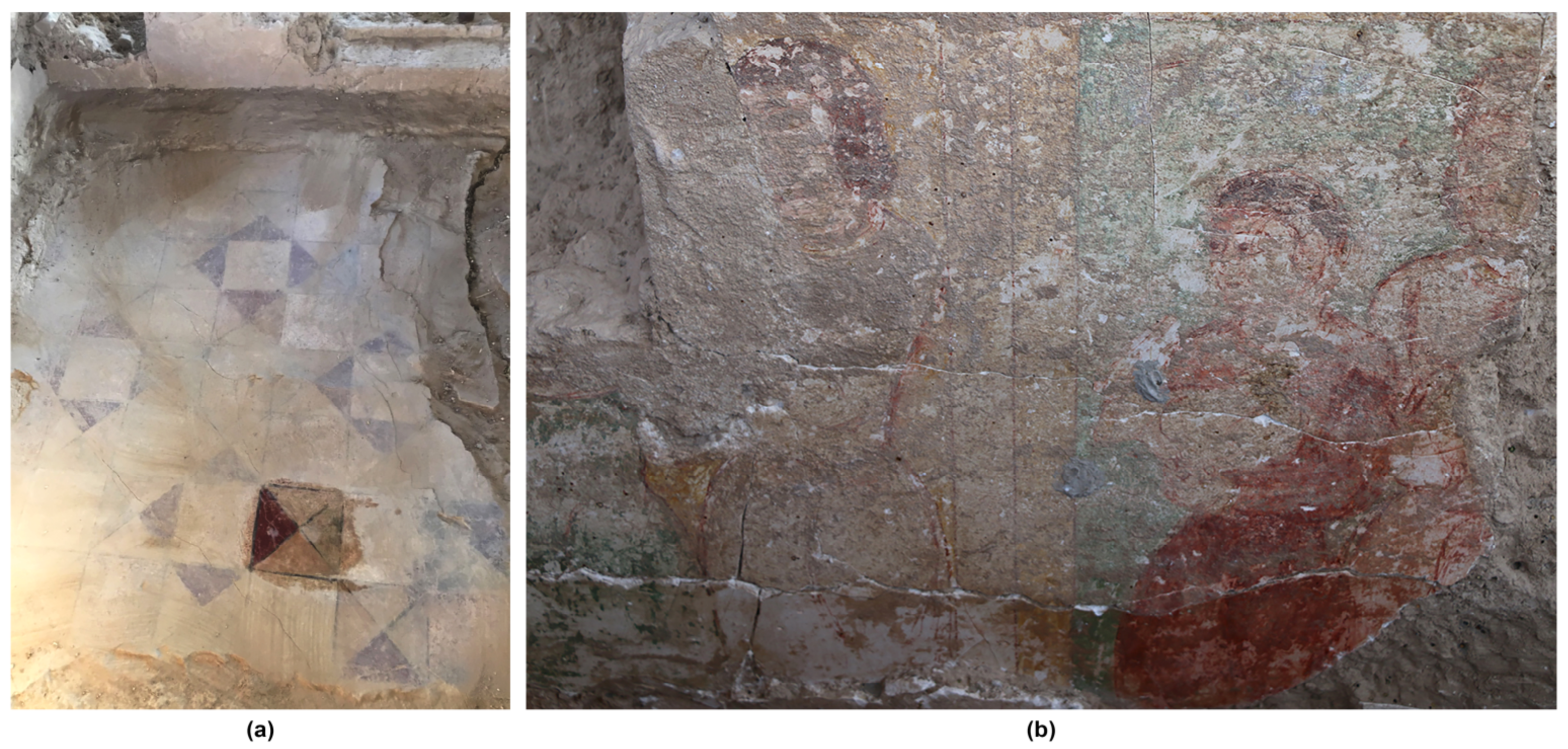
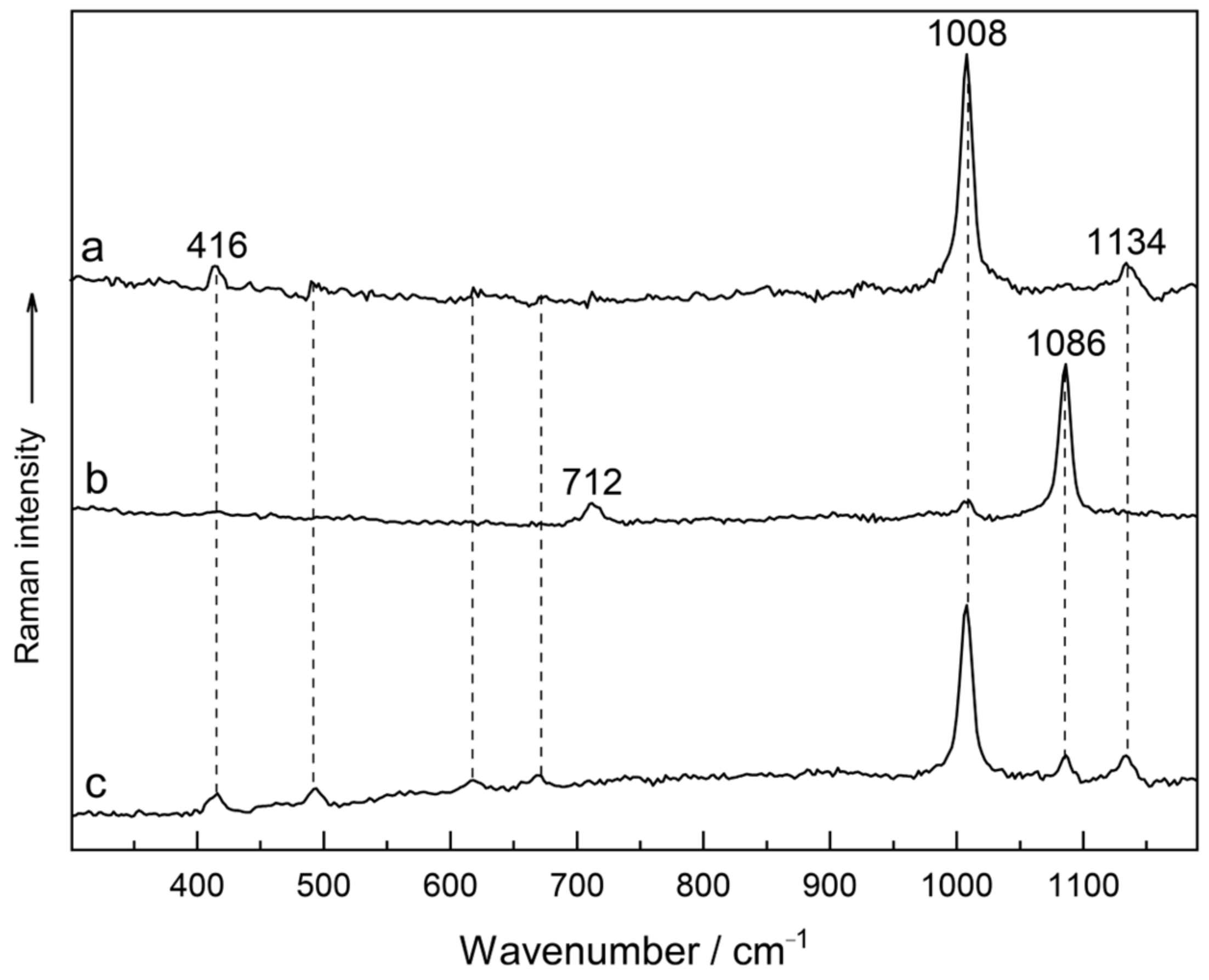
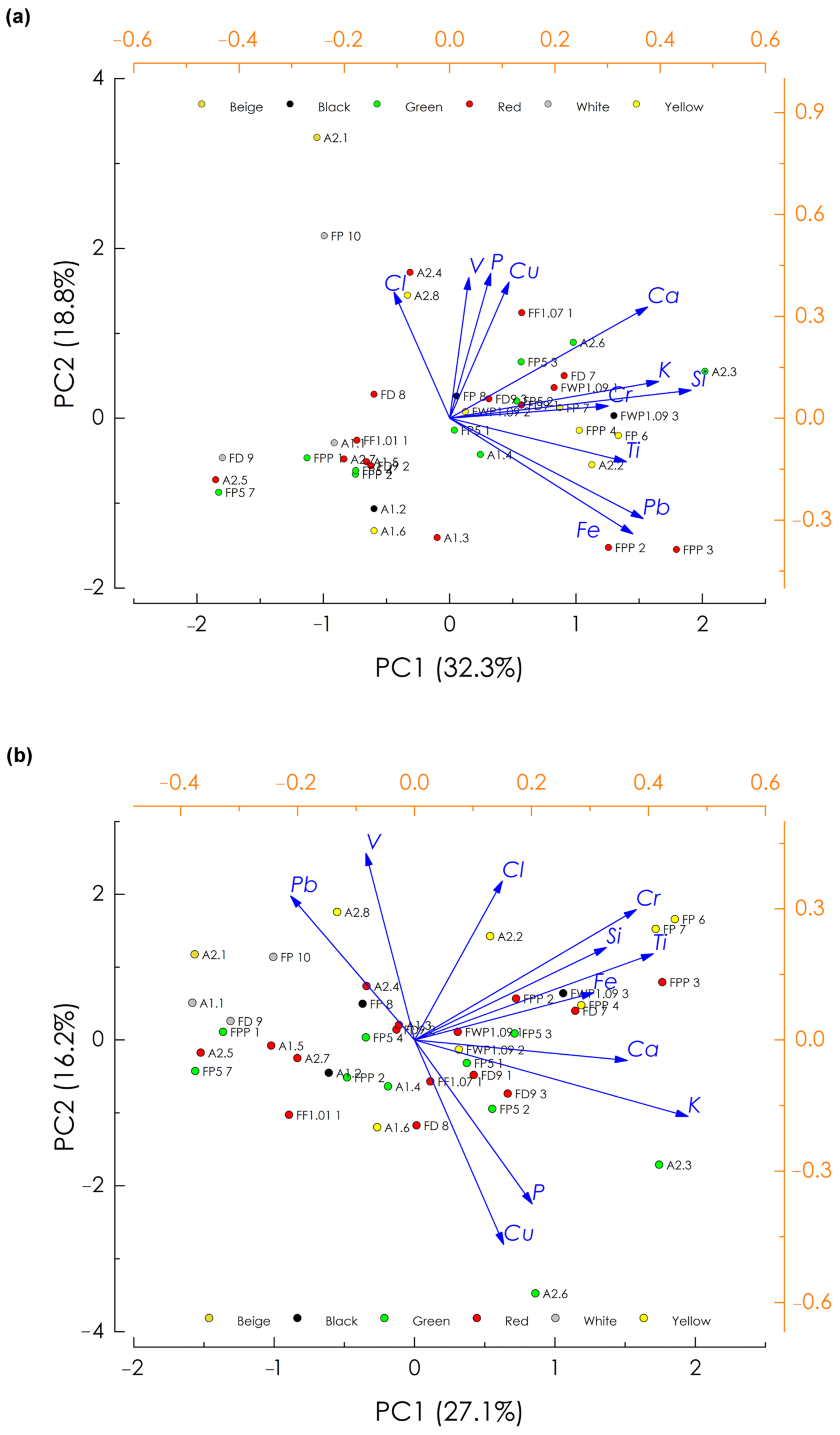

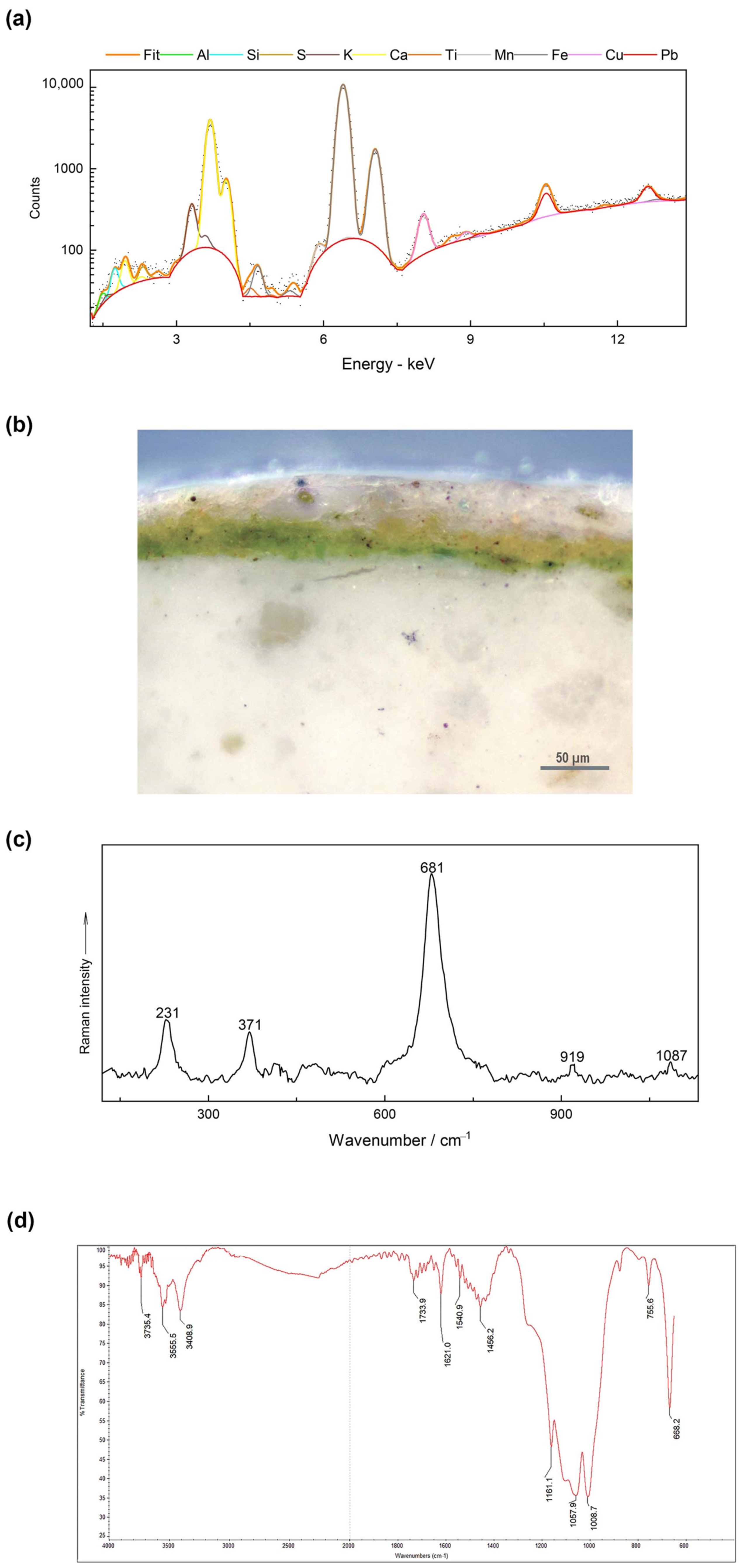
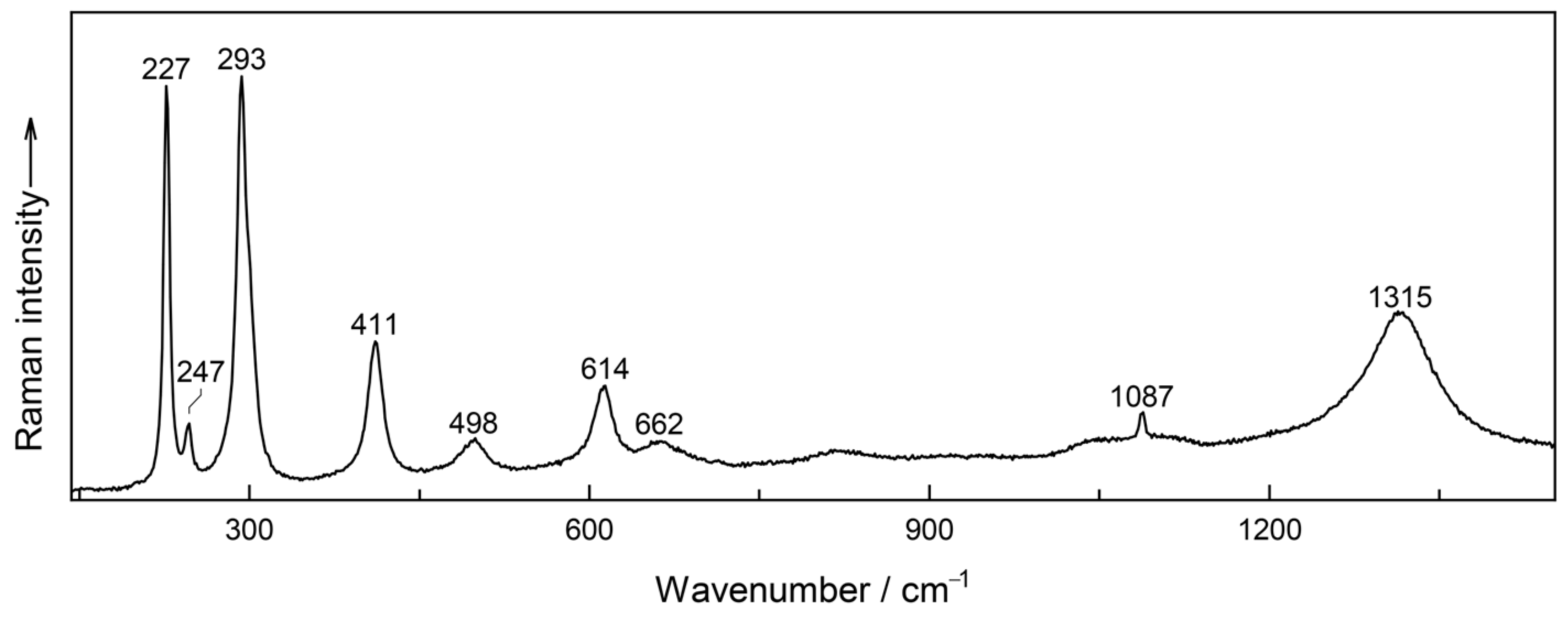
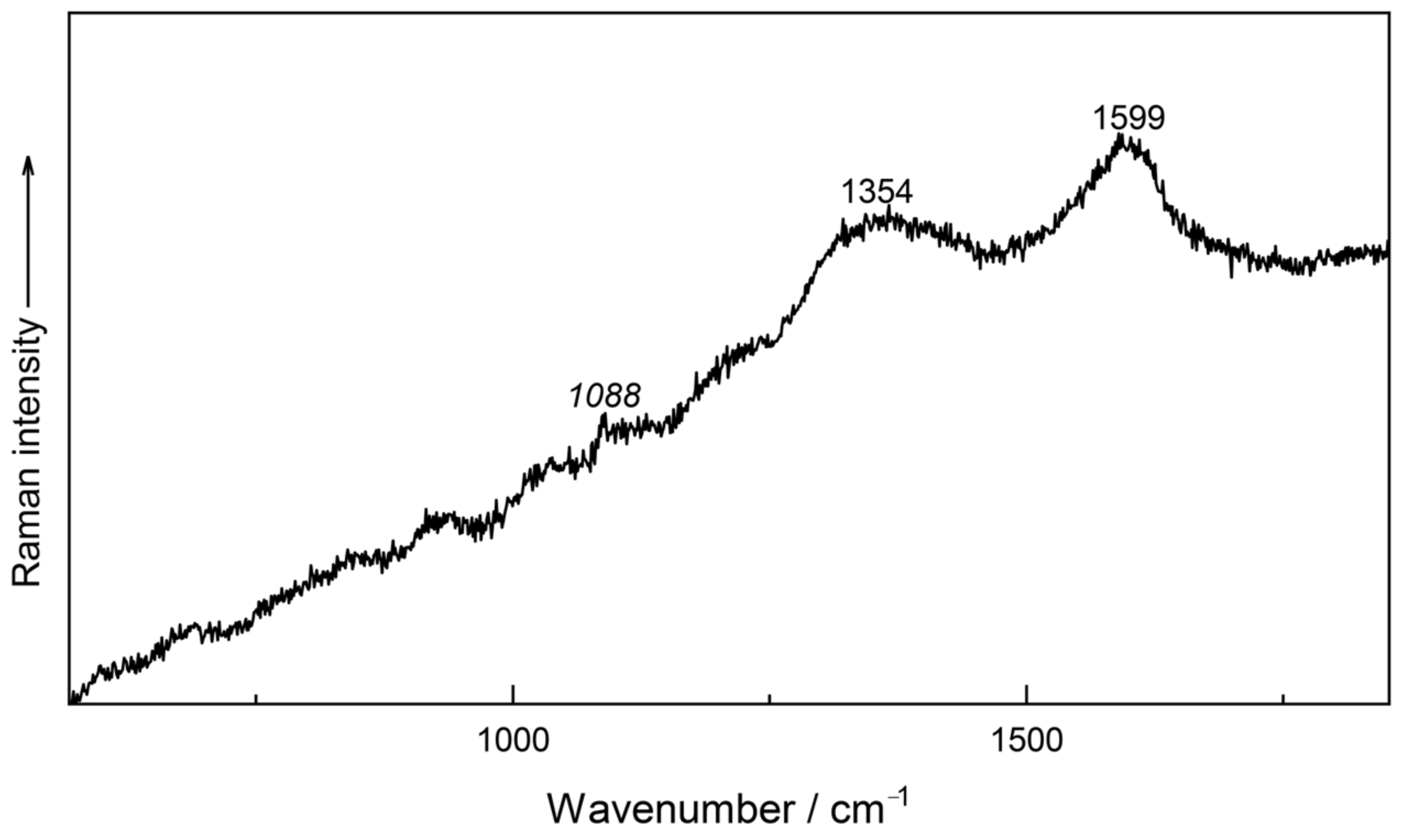
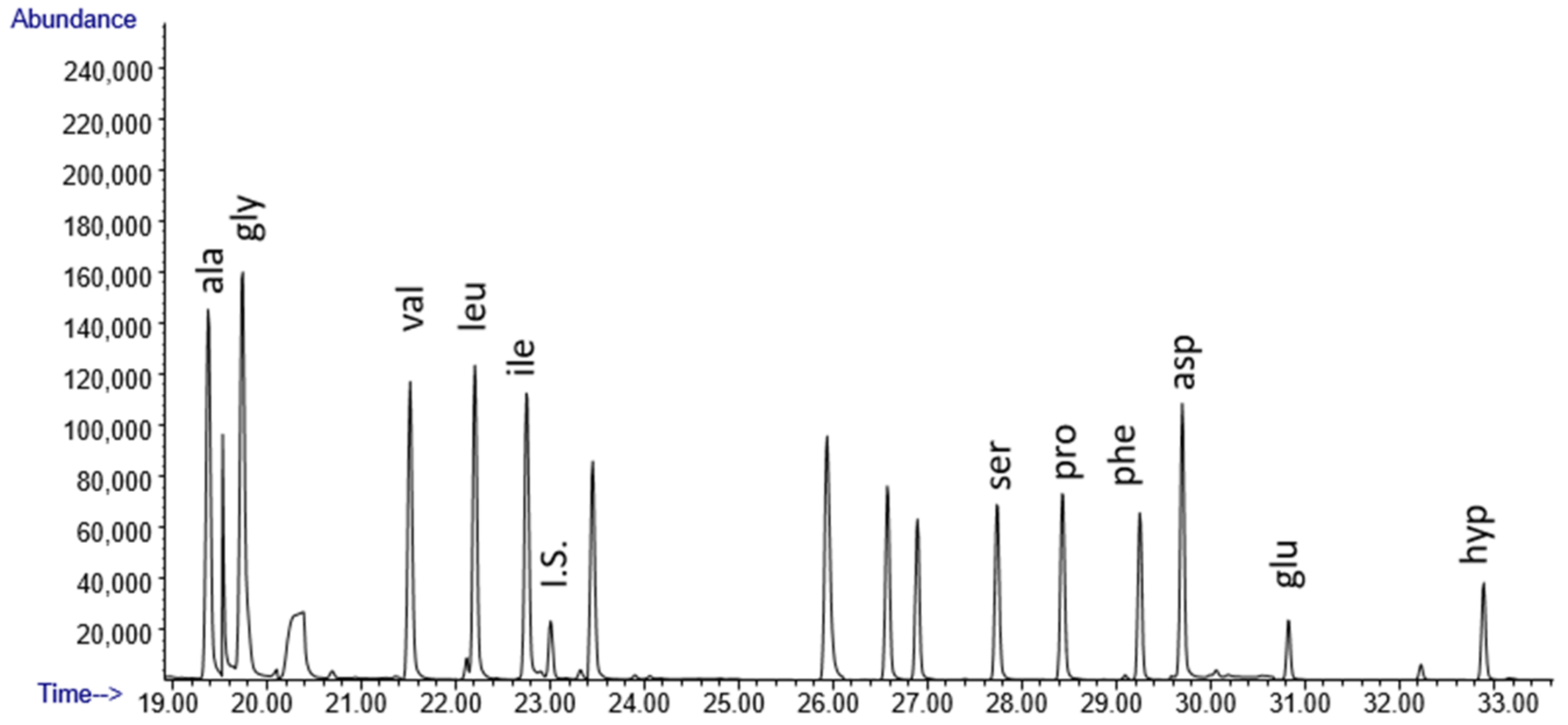
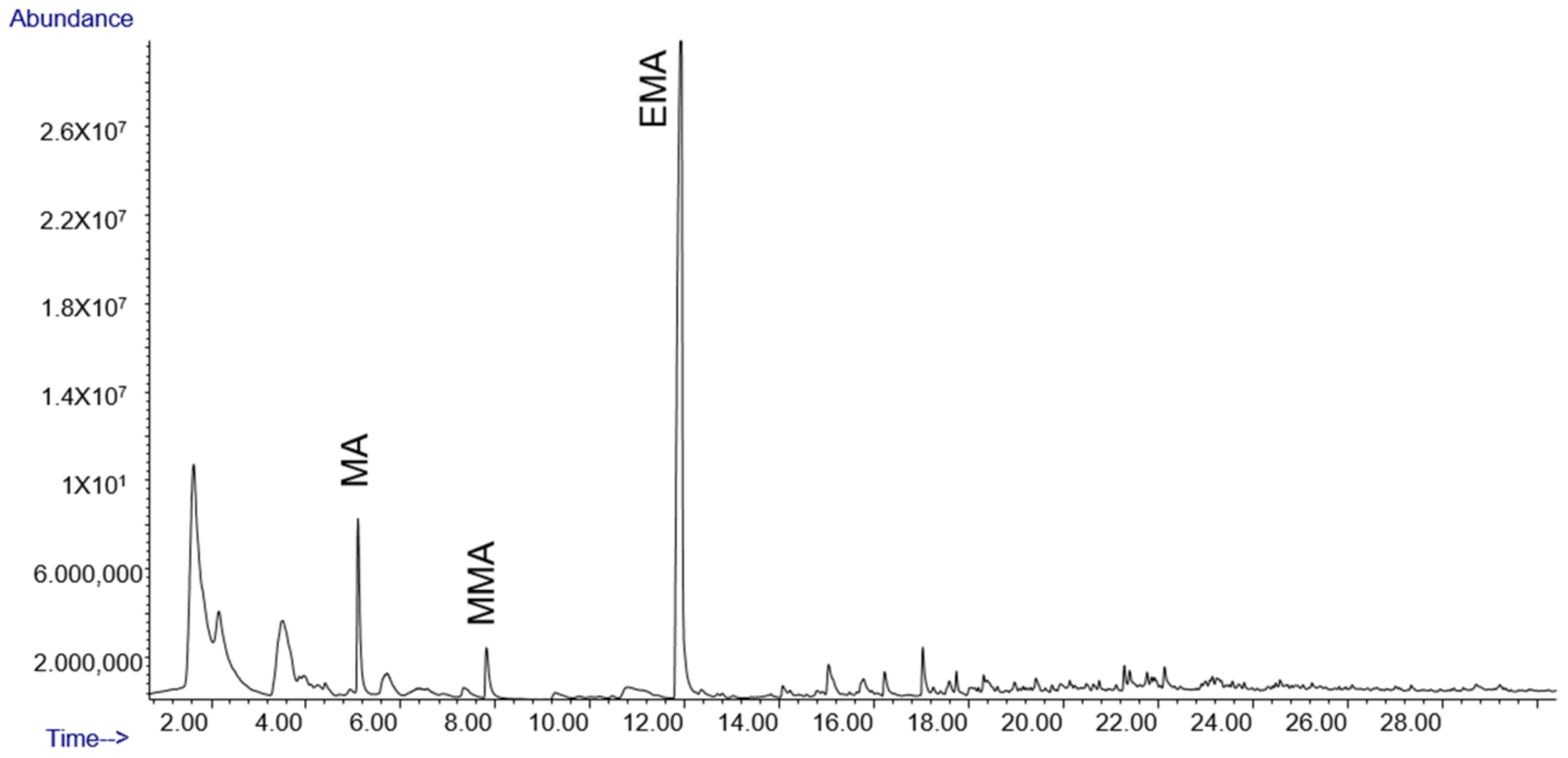
| Painted Polychrome Floor | ||
|---|---|---|
| Sample Code | Description | Micro Invasive Investigations |
| A1a | Red/black/yellow paint and plaster | PLM, SEM/EDS |
| A1b | Red paint and plaster | PLM, SEM/EDS |
| FP1 | Red paint and plaster | PLM, SEM/EDS, µ-Raman, GC-MS, Py-GC-MS |
| FP2 | Yellow paint l and plaster | PLM, SEM/EDS, µ-Raman, GC-MS, Py-GC-MS |
| FP3 | Black edge, yellow paint and plaster | PLM, SEM/EDS, µ-Raman, GC-MS, Py-GC-MS |
| FP4 | White paint and plaster | PLM, SEM/EDS, µ-Raman |
| FP4 a | White paint and plaster | µ-Raman |
| FP5 | Green paint and plaster | PLM, SEM/EDS, µ-Raman, GC-MS, Py-GC-MS |
| FP6 | Plaster | PLM, SEM/EDS, µ-Raman, GC-MS, Py-GC-MS |
| FP10 | Plaster | PLM, SEM/EDS, µ-Raman, GC-MS, Py-GC-MS |
| 287 | Green paint and plaster | PLM, SEM/EDS, µ-XRF |
| Wall Painting | ||
| Sample Code | Description | Micro Invasive Investigations |
| A2 | White paint and plaster | PLM, SEM/EDS |
| FD7 | Plaster | µ-Raman |
| FD8 | Plaster | SEM/EDS |
| FD9 | Red paint and plaster | SEM/EDS, Raman, GC-MS, Py-GC-MS |
| 288 | Yellow paint and plaster | SEM/EDS, µ-Raman, µ-XRF |
| 289 | Green paint and plaster | SEM/EDS, µ-Raman, µ-XRF, ATR-FTIR |
| 290 | Yellow paint and plaster | SEM/EDS, µ-Raman, µ-XRF |
Disclaimer/Publisher’s Note: The statements, opinions and data contained in all publications are solely those of the individual author(s) and contributor(s) and not of MDPI and/or the editor(s). MDPI and/or the editor(s) disclaim responsibility for any injury to people or property resulting from any ideas, methods, instructions or products referred to in the content. |
© 2024 by the authors. Licensee MDPI, Basel, Switzerland. This article is an open access article distributed under the terms and conditions of the Creative Commons Attribution (CC BY) license (https://creativecommons.org/licenses/by/4.0/).
Share and Cite
Amadori, M.L.; Mengacci, V.; Callieri, P.; Askari Chaverdi, A.; Bartolucci, M.; Eftekhari, N.; Andreotti, A.; Holakooei, P. Integrated Investigations of Painting Materials in the Sasanian City of Ardaxšīr Khwarrah, near Firuzabad (Southern Iran). Heritage 2024, 7, 1202-1220. https://doi.org/10.3390/heritage7030058
Amadori ML, Mengacci V, Callieri P, Askari Chaverdi A, Bartolucci M, Eftekhari N, Andreotti A, Holakooei P. Integrated Investigations of Painting Materials in the Sasanian City of Ardaxšīr Khwarrah, near Firuzabad (Southern Iran). Heritage. 2024; 7(3):1202-1220. https://doi.org/10.3390/heritage7030058
Chicago/Turabian StyleAmadori, Maria Letizia, Valeria Mengacci, Pierfrancesco Callieri, Alireza Askari Chaverdi, Matteo Bartolucci, Negar Eftekhari, Alessia Andreotti, and Parviz Holakooei. 2024. "Integrated Investigations of Painting Materials in the Sasanian City of Ardaxšīr Khwarrah, near Firuzabad (Southern Iran)" Heritage 7, no. 3: 1202-1220. https://doi.org/10.3390/heritage7030058
APA StyleAmadori, M. L., Mengacci, V., Callieri, P., Askari Chaverdi, A., Bartolucci, M., Eftekhari, N., Andreotti, A., & Holakooei, P. (2024). Integrated Investigations of Painting Materials in the Sasanian City of Ardaxšīr Khwarrah, near Firuzabad (Southern Iran). Heritage, 7(3), 1202-1220. https://doi.org/10.3390/heritage7030058







